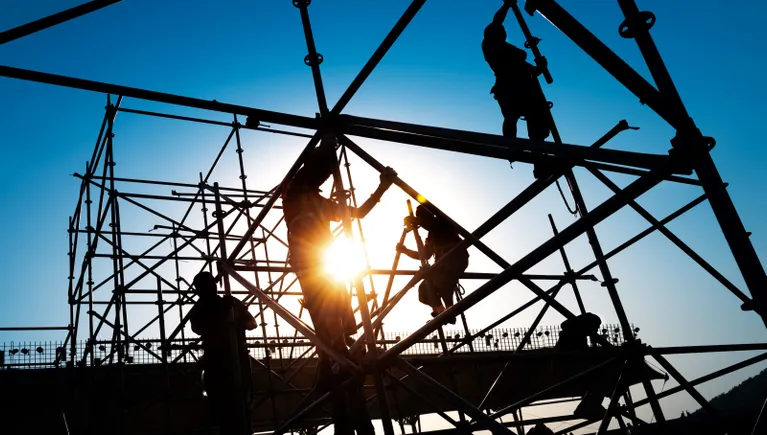The construction industry experienced varying degrees of demand in 2024, with some sectors booming and others losing steam.
As prolonged high interest rates slowed private building, federal funding from the Infrastructure Investments and Jobs Act continued to jumpstart public projects such as highways and bridges, and the CHIPS and Science Act spurred data center and manufacturing construction. Meanwhile, demand has lessened for multifamily and office building.
These shifting demands have had an impact on construction hiring.
For example, Derek Cunz, CEO of Minneapolis-based Mortenson, said his firm is hiring 250 college graduates this year and will make 500-plus noncraft experienced hires while growing its full-time craft workforce to over 4,000 to help deliver various projects. In particular, Cunz said he’s bullish on energy storage, a sector in which Mortenson boasts over 40 projects in its portfolio.
For contractors not in those booming sectors, the labor shortage may remain steep. They’re not just competing with fellow construction employers for workers, but also against other industries that offer long-term jobs, such as industrial, warehousing and manufacturing.
Still, overall demand for construction workers may decrease in the new year, according to Anirban Basu, chief economist for Associated Builders and Contractors.

Anirban Basu
Permission granted by ABC
“The construction labor market has weakened and maybe will weaken further still in 2025,” said Basu. “Not for everyone, not for contractors that have the benefit of participating on those ongoing megaprojects. But for many other contractors, 2025 stands to be the worst year for deal flow since the end of the pandemic. And that, of course, will have an impact on their staffing decisions.”
There’s also a regional aspect to the staffing trends, Basu said. In places such as Arizona, central Ohio, Texas, Georgia and Michigan, major builds are draining communities of their construction delivery capacity.
When the majority of the regional workforce is on one project, that also provides job security for those not working on it, Basu said, as they have less competition for what construction job openings remain.
In the new year, projects in booming sectors will likely have little trouble with staffing, and projects in softer sectors will struggle to fill positions, or have to offer a higher wage to compete.
Megaprojects drive moderate wages
Experts told Construction Dive they believe that the multiyear nature of projects like enormous data center campuses — such as Meta’s $10 billion Monroe, Louisiana, project that will require 5,000 construction workers — provide long-term job security that is attractive to workers, so they are willing to accept the tradeoff of moderate wages.
Salaries have leveled off as workers are drawn to larger projects, said Aaron Faulk, national construction practice leader for Seattle-based accounting firm Moss Adams.
In 2023, around 60% of construction firms said they changed their compensation structure, increasing salaries or benefits, according to a national Moss Adams survey of 274 firms. In 2024, the number of firms increasing salaries was down to 42%, Faulk said, indicating competition wasn’t as fierce as the year prior.
He attributed this in part to the variability in different construction sectors.

Aaron Faulk
Permission granted by Moss Adams
“Some segments are really strong right now, if you look at data center or energy or industrial and manufacturing,” Faulk said. “Then there is the weakness though in multifamily, office. And so I think some of the contractors that are really busy have been able to get people without having to have massive compensation adjustments.”
Ongoing federal funding should continue to fuel civil work and keep wages steady in the year ahead. The government hasn’t deployed all of the funding from the major legislation yet, Faulk noted. Three years into the five-year federal law, 47% of IIJA funds have been announced.
Faulk said federal funding would help keep compensation for workers on these jobs steady and “solid” compared to the past, when employers may have needed to consider more frequent wage hikes.
The firms actually working on those long-term projects are in the minority, however. A survey of members of the Associated General Contractors of America found that 18% of members have performed work on projects funded by the IIJA, while another 5% have won work funded by the IIJA, but yet not started. Nearly a third of respondents don’t anticipate the law will change their portfolio.
At the same time, respondents said they anticipated 15 of 17 major sectors to see increased spending in 2025 compared to 2024. Though the highest expectations rest on sectors like data centers and transportation, AGC members also predict growth in education, healthcare and government buildings.
As a result, the vast majority of respondents said they intend to increase headcount and that securing labor for projects in 2025 is among their top concerns and challenges for the year. And 53% of the 1,109 AGC respondents increased base pay rates in 2024 — 11% more than the firms from Faulk’s survey.
Upskilling for the future
No matter what type of projects they work on, there are steps that contractors can take to ensure that they are the employer of choice in their markets. Upskilling workers and giving them the tools to fill in-demand positions is vital.
“That’s phenomenally important,” Basu said of training the workforce. “That’s how we create a larger middle class by exposing these less experienced construction workers to training programs, apprenticeship programs that allow them to develop higher-in-demand skillsets, whether it is for carpentry, electrical work, HVAC, et cetera.”
To get projects done on a timely basis, those skills and experiences will be vital. Faulk said employers are planning accordingly.
“Every single contractor has that issue where you have highly skilled people that are leaving the workforce typically because they’re aging out. And how do you replace those people when there aren’t enough talented people in the pipeline to replace them?” Faulk said. “They’re focused on productivity and also training those folks to get them up to speed as fast as possible.”
Indeed, Cunz said part of Mortenson’s plans for growing its full-time workforce includes investing in training and growth opportunities.
The emerging workforce — largely made up of Gen Z — may be a good fit for the trades due to disillusionment with paying for a four-year degree.

Kit Dickinson
Permission granted by ADP
“The way I see it is we’re really at an inflection point, where the Gen Z population is embracing that belief that if you want to be part of a growing industry and have career growth potential, job security and good income possibilities, that path may best be achieved by going into the trades,” Kit Dickinson, construction industry executive at ADP, told Construction Dive in October.
Experts say contractors should consider investing in technology, reverse mentoring and cultural changes to ensure jobsites are welcoming to all types of workers.
“What used to be kind of a nice-to-have, that we need to branch out and explore other generations and younger workers and such, is now a need-to-have because there’s just too much work,” Dickinson said. “What keeps you up at night as a business owner is attracting and retaining the skilled labor needed to meet the demands.”
Correction: This story has been updated to clarify the number of college graduates Mortenson plans to hire early this year.
